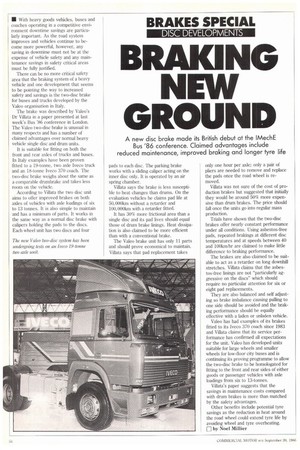BRAKING NEW ROUND
Page 56

If you've noticed an error in this article please click here to report it so we can fix it.
A new disc brake made its British debut at the IMechE Bus '86 conference. Claimed advantages include reduced maintenance, improved braking and longer tyre life
MI With heavy goods vehicles, buses and coaches operating in a competitive environment downtime savings are particularly important. As the road system improves and vehicles continue to become more powerful, however, any saving in downtime must not be at the expense of vehicle safety and any maintenance savings in safety critical areas must be fully justified.
There can be no more critical safety area that the braking system of a heavy vehicle and one development that seems to be pointing the way to increased safety and savings is the two-disc brake for buses and trucks developed by the Valeo organisation in Italy.
The brake was described by Valeo's Ur Villata in a paper presented at last week's Bus '86 conference in London. The Valeo two-disc brake is unusual in many respects and has a number of claimed advantages over normal heavy vehicle single disc and drum units.
It is suitable for fitting on both the front and rear axles of trucks and buses. In Italy examples have been proven fitted to a 19-tonne, two axle Iveco truck and an 18-tonne Iveco 370 coach. The two-disc brake weighs about the same as a comparable drumbrake and takes less room on the vehicle.
According to Villata the two disc unit aims to offer improved brakes on both axles of vehicles with axle loadings of six to 13 tonnes. It is also simple to maintain and has a minimum of parts. It works in the same way as a normal disc brake with calipers holding the pads to the discs. Each wheel unit has two discs and four pads to each disc. The parking brake works with a sliding caliper acting on the inner disc only. It is operated by an air spring chamber.
Villata says the brake is less susceptible to heat changes than drums. On the evaluation vehicles he claims pad life at 50,000kin without a retarder and 100,000km with a retarder fitted.
It has 30% more frictional area than a single disc and its pad lives should equal those of drum brake linings. Heat dissipation is also claimed to be more efficient than with a conventional brake.
The Valeo brake unit has only 11 parts and should prove economical to maintain. Villata says that pad replacement takes only one hour per axle; only a pair of pliers are needed to remove and replace the pads once the road wheel is removed.
Villata was not sure of the cost of production brakes but suggested that initially they would be around 50% more expensive than drum brakes. The price should fall once the units go into regular mass production.
Trials have shown that the two-disc brakes offer nearly constant performance under all conditions. Using asbestos-free pads, repeated brakings at different disc temperatures and at speeds between 40 and 100km/hr are claimed to make little difference to braking performance.
The brakes are also claimed to be suitable to act as a retarder on long downhill stretches. Villata claims that the asbestos-free finings are not "particularly aggressive on the discs" which should require no particular attention for six or eight pad replacements.
They are also balanced and self adjusting so brake imbalance causing pulling to one side should be avoided and the braking performance should be equally effective with a laden or unladen vehicle.
Valeo has had examples of its brakes fitted to its Iveco 370 coach since 1983 and Villata claims that its service performance has confirmed all expectations for the unit. Valeo has developed units suitable for large wheels and smaller wheels for low-floor city buses and is continuing its proving programme to allow the two-disc brake to be homologated for fitting to the front and rear sides of either goods or passenger vehicles with axle loadings from six to 13-tonnes.
Villata's paper suggests that the savings in maintenance costs compared with drum brakes is more than matched by the safety advantages.
Other benefits include potential tyre savings as the reduction in heat around the road wheel could extend tyre life by avoiding wheel and tyre overheating. LII by Noel Millier
























































































































